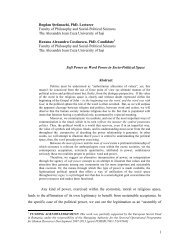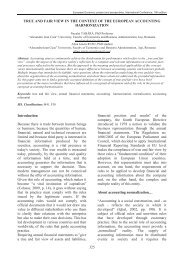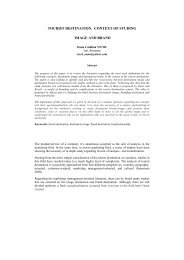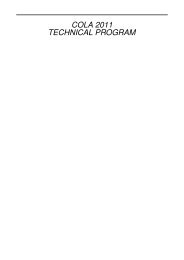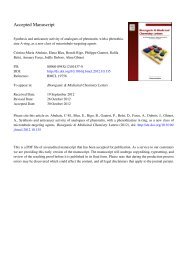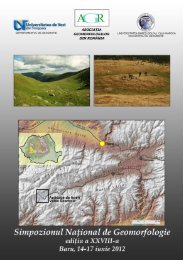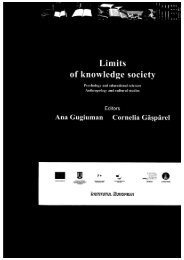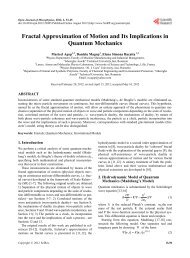Download Pdf Article - Revista de Chimie
Download Pdf Article - Revista de Chimie
Download Pdf Article - Revista de Chimie
Create successful ePaper yourself
Turn your PDF publications into a flip-book with our unique Google optimized e-Paper software.
Transmission Factor of N-(4-methoxybenzyli<strong>de</strong>ne)-4-butylaniline<br />
(MBBA) Liquid Crystalline Layer Between Crossed Polarizers<br />
CARMEN-FELICIA DASCALU, BEATRICE-CARMEN ZELINSCHI, DANA ORTANSA DOROHOI<br />
”Alexandru Ioan Cuza” University, Faculty of Physics, 11 Carol I Bdv, 700506, Iasi, Romania<br />
The aim of this paper is to obtain information about the transmission factor of MBBA crystalline layer<br />
between crossed polarizers. The liquid crystalline layer is kept in a special cell and an external electrostatic<br />
field is applied between the walls of the cell. The birefringence of MBBA in the spectral range 470-750nm<br />
was calculated by using Cauchy formula on the basis of three experimental values of the main refractive<br />
indices of the liquid crystal in an external electric field of about 53.57kV/m previously <strong>de</strong>termined.<br />
Keywords: MBBA in external electrostatic field, birefringence, Cauchy formula, transmission factor<br />
Between isotropic liquids and crystalline solids liquid<br />
crystals (LCs) are intermediate phases (named<br />
mesophases) [1] consisting of complex molecular<br />
systems which involve short and long range intermolecular<br />
interactions [2].<br />
In accordance with the physical parameters controlling<br />
the existence of the liquid crystalline phases there are two<br />
types of liquid crystals thermotropic and lyotropic.<br />
Thermotropic LC materials usually contain a single type of<br />
chemical compound and their mesophases appear<br />
primarily as function of temperature [1]. Lyotropic liquid<br />
crystals are mixtures in which one is a simple liquid and<br />
the other one is an amphilic compound. In the case of<br />
lyotropic LCs the most important variable that influences<br />
the existence of the liquid crystalline phase is the<br />
concentration [3].<br />
The mesophases can be distinguished by their optical<br />
properties revealed in phenomena such as reflection,<br />
refraction, nonlinear response, optical wavegui<strong>de</strong> and light<br />
scattering [4].<br />
The uniax liquid crystals are characterized by two values<br />
of the refractive in<strong>de</strong>x: the ordinary value (n o<br />
) and the<br />
extraordinary value (n e<br />
) [5]. Ordinary value is measured<br />
with light having the electric field perpendicular on the<br />
optical axis and the extraordinary value is measured with<br />
light having the electric field in the principal section plane<br />
<strong>de</strong>termined by the optical axis and the light propagation<br />
direction [5, 6].<br />
The birefringence of the liquid crystals is the difference<br />
between the extraordinary and the ordinary refractive<br />
indices and it can be consi<strong>de</strong>red as function of the internal<br />
<strong>de</strong>gree of or<strong>de</strong>r [6].<br />
In Optics, there are a few wavelengths in the visible<br />
range for which the main refractive indices of MBBA liquid<br />
crystal were measured, but some empirical relationships<br />
permit us to estimate, in some approximations, the<br />
refractive indices at each light wavelength in a given<br />
spectral range. The refractive in<strong>de</strong>x of a transparent<br />
material can be estimated by the Cauchy formula [7-9]:<br />
(1)<br />
where n is the refractive in<strong>de</strong>x, λ is the wavelength of<br />
light, A, B and C are material-<strong>de</strong>pen<strong>de</strong>nt specific constants.<br />
The coefficients A, B and C can be <strong>de</strong>termined by fitting<br />
the equation (1) for measured refractive indices at three<br />
wavelengths [9]. The Cauchy’s formula is typically used in<br />
the transparence range of the material for normal<br />
dispersion [8].<br />
In the anisotropic uniax media the dispersion of<br />
extraordinary (e) and ordinary (o) refractive indices can<br />
be expressed by (2) [7]:<br />
Consequently, the dispersion of the visible birefringence<br />
[8] can be estimated using relation:<br />
Experimental part<br />
The main refractive indices and the birefringence of<br />
MBBA LC in the presence of an external electric field applied<br />
between the internal walls of the cell were previously<br />
<strong>de</strong>termined for some monochromatic visible radiations<br />
[10]. Pure N-(4-methoxybenzyli<strong>de</strong>ne)-4-butylaniline was<br />
purhased from Merck Company and used at 23 o C.<br />
The method for the birefringence <strong>de</strong>termination was<br />
<strong>de</strong>scribed in a previous paper [11].<br />
In this paper, the LC was studied in the presence of an<br />
external electric field (E=53.57kV/m) applied between the<br />
internal walls of the cell.<br />
Results and discussions<br />
The main refractive indices of MBBA LC in the presence<br />
of an electrostatic field were measured with Rayleigh<br />
interferometer for three different wavelengths of light (table<br />
1) [10].<br />
Cauchy fitting coefficients for dispersion of the main<br />
refractive indices of MBBA LC in the presence of<br />
Table 1<br />
THE MAIN REFRACTIVE INDICES OF MBBA LC AT<br />
E=53.57kV/m (L=14μm, T=296K)<br />
(2)<br />
(3)<br />
* email: dascalu_carmen_felicia@yahoo.com; Tel: 0746614223<br />
REV. CHIM. (Bucharest) ♦ 62♦ No. 5 ♦ 2011 http://www.revista<strong>de</strong>chimie.ro 585
Table 2<br />
CAUCHY FITTING COEFFICIENTS FOR THE<br />
ORDINARY AND EXTRAORDINARY REFRACTIVE INDICES<br />
Fig. 1. Main refractive indices of MBBA LC at 53.57kV/m vs.<br />
wavelength<br />
electrostatic field (table 2) were calculated using<br />
experimental data from table 1.<br />
The dispersion of the refractive indices (n o<br />
and n e<br />
) was<br />
simulated by using the Cauchy coefficients for ordinary<br />
and extraordinary refractive indices from table 2.<br />
The main refractive indices of MBBA LC in the presence<br />
of an external electric field can be established on the basis<br />
of the figure 1. For example, one can estimate that the<br />
ordinary and the extraordinary refractive indices are 1.567<br />
and 1.713 at wavelength λ=600nm.<br />
The birefringence of the MBBA LC was simulated for λ<br />
between 470 and 750nm (fig. 2). The simulation enlarges<br />
the spectral range in which the main refractive indices<br />
and the birefringence can be evaluated.<br />
Fig. 2. Birefringence of<br />
MBBA LC at 53.57kV/m vs.<br />
wavelength<br />
Application<br />
The simulated values of the birefringence were used in<br />
or<strong>de</strong>r to <strong>de</strong>termine the transmission factor of a LC layer<br />
between two crossed polarizers (for the case θ=45° where<br />
θ is the angle between the optical axis and the transmission<br />
direction of the polarizer) [12-15]. The transmission factor<br />
of the <strong>de</strong>vice is [11, 13]:<br />
where L is the thickness of the LC layer, Δn is the<br />
birefringence and λ is the light wavelength.<br />
The transmission factor of the <strong>de</strong>vice was simulated in<br />
function of the wavelength and the birefringence. The 3D<br />
graph was obtained for the thickness of the LC layer<br />
L=14μm.<br />
(4)<br />
Fig. 3. Transmission factor (T) of MBBA layer at 53.57kV/m between<br />
crossed polarizers vs. wavelength (λ) and birefringence (Δn)<br />
From figure 3 one can observe that the maxima of the<br />
transmission factor for Δn=0.16 are at aproximativelly<br />
497nm and 640nm. When the birefringence <strong>de</strong>creases at<br />
0.145 the maximum of the transmission factor is at 580nm<br />
and in the channeled spectrum there is only one band.<br />
Conclusions<br />
The values of the main refractive indices of a MBBA LC<br />
in the presence of external electric field of about 53.57kV/<br />
m were experimentally <strong>de</strong>termined for three wavelengths.<br />
The dispersion of the ordinary and extraordinary refractive<br />
indices in the spectral range 470 – 750nm was simulated<br />
using the <strong>de</strong>termined refractive indices and the Cauchy<br />
formula. Depending on the birefringence values, one or<br />
two transmission maxima were observed in the simulated<br />
spectrum of MBBA layer placed in electrostatic field.<br />
Acknowledgement: This work was supported by the European Social<br />
Fund in Romania, un<strong>de</strong>r the responsibility of the Managing Authority<br />
for the Sectoral Operational Programme for Human Resources<br />
Development 2007-2013 [grant POSDRU/88/1.5/S/47646].<br />
References<br />
1. DEMUS, D., GOODBY, J., GRAY, G.W., SPIESS, H.-S., VILL, V.,<br />
Handbook of Liquid Crystals, vo. 3, Wiley-VCH, 1998<br />
2. LI, J., WU, S.-T., Journal of Applied Physics, vo. 95, no. 3, 2004, p.<br />
896<br />
3. COLLINGS, P. J., Liquid Crystals: Nature’s Delicate Phase of Matter,<br />
2nd edition, Princeton University Press, New Jersey, 1990<br />
4. KHOO, I. C., WU, S-T., Optics and Nonlinear Optics of Liquid<br />
Crystals, World Scientific, Singapore, 1993<br />
586<br />
http://www.revista<strong>de</strong>chimie.ro<br />
REV. CHIM. (Bucharest) ♦ 62♦ No. 5 ♦ 2011
5.DOROHOI, D. O., Fundamental Optics, Addleton Aca<strong>de</strong>mic<br />
Publishers, New York, 2010<br />
6. PICOS, S., AMARANDEI, G., DIACONU I., DOROHOI, D.O., Journal of<br />
Optoelectronics and Advanced Materials, vol. 7, no. 2, 2005, p. 787<br />
7. DUMITRASCU, L., DUMITRASCU, I., DOROHOI, D. O., Rev. Chim.<br />
(Bucharest), 60, no. 11, 2009, p. 1220<br />
8. DUMITRASCU, L., DUMITRASCU, I., DOROHOI, D.O., DIMITRIU, D.,<br />
AFLORI, M., APREUTESEI, G., Complemente <strong>de</strong> fizica pentru stu<strong>de</strong>ntii<br />
scolilor doctorale, Ed. TehnoPress, Iasi, 2007<br />
9. LI, J., WU, S-T., Journal of Applied Physics, 96, 1, 2004, p. 170<br />
10. DUMITRASCU, L., DOROHOI, D. O., Elemente <strong>de</strong> optica mediilor<br />
anizotrope. Aplicatii, Ed. Tehnopress, Iasi, 2009<br />
11. DASCALU, C.-F., ZELINSCHI, B.C., DOROHOI, D.O., Rev.<br />
Chim.(Bucharest), in press<br />
12. BARAN J., POSTOLACHE M., POSTOLACHE M., Journal of<br />
Optoelectronics and Advanced Materials, 8 , no. 4, 2006, p. 1529<br />
13. DUMITRASCU, L., DUMITRASCU, I., DOROHOI, D. O., Rev. Chim.<br />
(Bucharest), 60, no. 11, 2009, p. 1220<br />
14. DUMITRASCU, I., DUMITRASCU, L., DOROHOI, D. O., Journal of<br />
Optoelectronics and Advanced Materials, 8, no. 3, 2006, p.1028<br />
15. DUMITRASCU, I., DOROHOI, Proprietati optice ale mediilor cu<br />
ordonare partiala. Aplicatii, Tehnopress, Iasi, 2009<br />
Manuscript received: 17.03.2011<br />
REV. CHIM. (Bucharest) ♦ 62♦ No. 5 ♦ 2011 http://www.revista<strong>de</strong>chimie.ro 587



